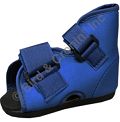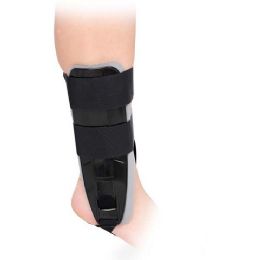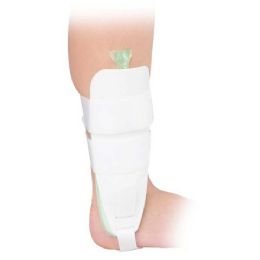
An ankle brace is a medical device used to immobilize, protect and support a comfortable alignment of the foot and ankle to assist in helping to heal muscle strains, ligament sprains and unstable joints. Ankle braces and supports also help provide support for instability, contractures, injuries, plantar fasciitis, fractures, and other lower leg problems. They can help speed up recovery and reduce the chance of reinjuring the affected area.



What is an Ankle Brace?
An ankle brace is a device that provides support to the ankle, and may be recommended by a physical therapist, prescribed by a physician, or worn independently by those who believe it could give more support. There are many different types of ankle braces available, depending on each specific need. Ankle braces are also worn in a variety of settings. A strained or sprained ankle can benefit from bracing to stabilize and immobilize the ankle while it is healing. The goal is to prevent further injury by using a brace, and walking with an ankle brace can help avoid putting stress on the affected ankle and foot.
As part of an orthopedic corrective program, bracing can also be used. An individual with excessive supination or pronation which causes the ankle to turn out or in, may wear a brace to help support it and prevent ankle supination or pronation. Bracing can also be used to support an ankle after surgery to fix a congenital abnormality, fracture, or problem such as a ruptured tendon. The bracing relieves strain on the ankle to help prevent additional injury. If ankle instability is detected, an ankle brace can help provide support until the joint is strong enough for walking without a brace. Bracing can also be used to stabilize an ankle while an individual waits for surgery. This can keep pain levels minimized and reduce the risk that the ankle will become even more negatively affected during the wait.
When fitting an ankle brace, care should be taken to ensure that it fits snugly but not too tightly, to avoid chafing and other common problems. The brace needs to fit evenly without creating painful areas or hot spots. If the ankle appears hot, swollen, tender, or red after bracing, it is a sign that there is a problem with the brace.
What are the Various Types of Ankle Supports?
Choosing an ankle support depends mainly on what kind of injury has occurred. Moderate support braces, maximum support braces, walking boots, and bandages are the most commonly used supports. There are also ankle supports used to prevent and stabilize an injury. The ankle is made of the tibia, fibula, and talus bones, and three ligaments are attached to these bones. Altogether, the ligaments and bones make up the ankle joint. The ligaments allow motion within the joint, along with providing stability.
A tear may result from overstretching a ligament, known as a sprain. Sprains are categorized by the amount of damage that is done to the ligament. A Grade I sprain is the least serious and the most common of these injuries. There is normally no actual tear in the ligament, but instead there is damage that is related to overstretching. A Grade II sprain will usually have a partially torn ligament. A Grade III sprain indicates a severe tear of the ligament which results in instability of the joint.
To compress the affected area without restricting movement, an elastic bandage ankle support is used. This type may be in the form of a pull-on sock or a long bandage. This flexible brace offers stability and comfort and is often used for arthritis pain or Grade I sprains. This type of support may also be used to help prevent injury for those with a weakened joint.
Grade II sprains and other ligament injuries can use a moderate brace for ankle support. These types of injuries often cause pain when walking, along with swelling and stiffness. To help stabilize the ankle, a moderate ankle support offers more rigid panels with lacing or Velcro to create a customized, effective fit.
A maximum support ankle brace is used for severe injuries, which include Grade III sprains and ligament ruptures that are characterized by acute swelling, severe pain, and the inability to rotate the ankle. The goals of this type of support are to allow ambulation with decreased pain, compress the area, offer support during rehabilitation, and prevent the ankle from rotating inward or outward.
A walking boot may be prescribed for Grade III sprains, fractures of the foot or ankle, or post-operatively for support and protection. The outer shell is normally rigid with padding of either air-filled cells or a quilted, breathable fabric. Walking boots are typically fastened with Velcro straps, and the bottom is usually made with a rocker sole to decrease stress on the foot.
What is a Walking Boot?
A walking boot is an orthopedic boot specifically made to be used to help support the ankle, foot, or calf, and immobilize the affected part. Also known as a boot cast or brace boot, the walking boot can be used for various injuries or conditions affecting parts of the foot or lower leg. The temporary use of a walking boot can help bursitis, tendinitis, and some forms of arthritis. In these cases, using a walking boot for several weeks can allow the affected area to rest and heal. This can be utilized as a safety measure to avoid putting stress or strain on the injured area. Some individuals that are recovering from foot surgery may suffer from slight swelling of the foot or ankle. In this case, a walking boot may help reduce pressure and offer support while walking.
A benefit of using a walking boot is the freedom it allows an individual to not be dependent on a cane, crutches, or walker in most cases. This allows the ability to keep one’s hands free and to move about freely while the affected foot is supported by this specially crafted brace. It is most commonly made from sturdy aluminum, and is typically wider than a normal type of boot. They can be available in most sizes for adults as well as children, and used on either the left or right foot. Walking boots typically come with a removable liner and most are machine washable.
Rehabmart is pleased to carry a comprehensive selection of ankle braces and supports from superior quality vendors, including DeRoyal, Bauerfeind, Orthomerica, Restorative Care of America, Chattanooga, Comfy Splints, Mabis, Sammons Preston, North Coast, BSN Medical and United Surgical.
Mike Price, OT
Rehabmart Co-Founder & CTO